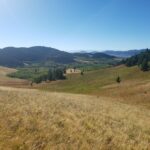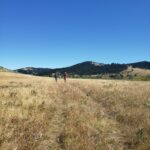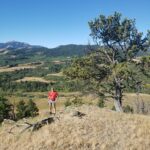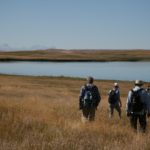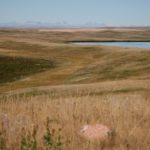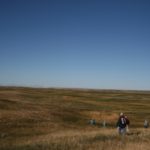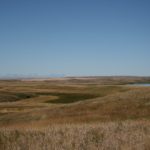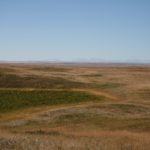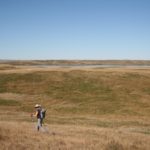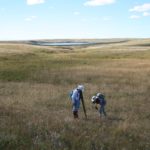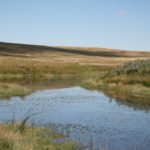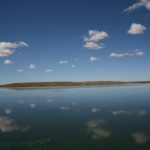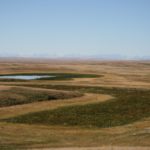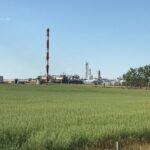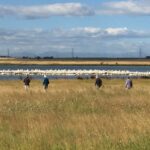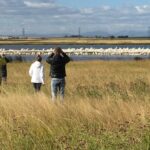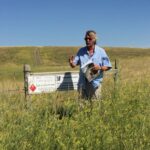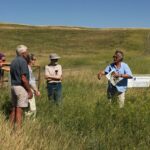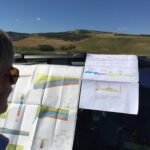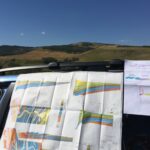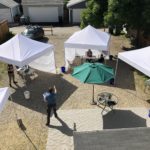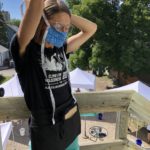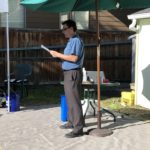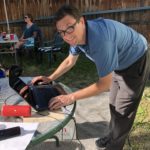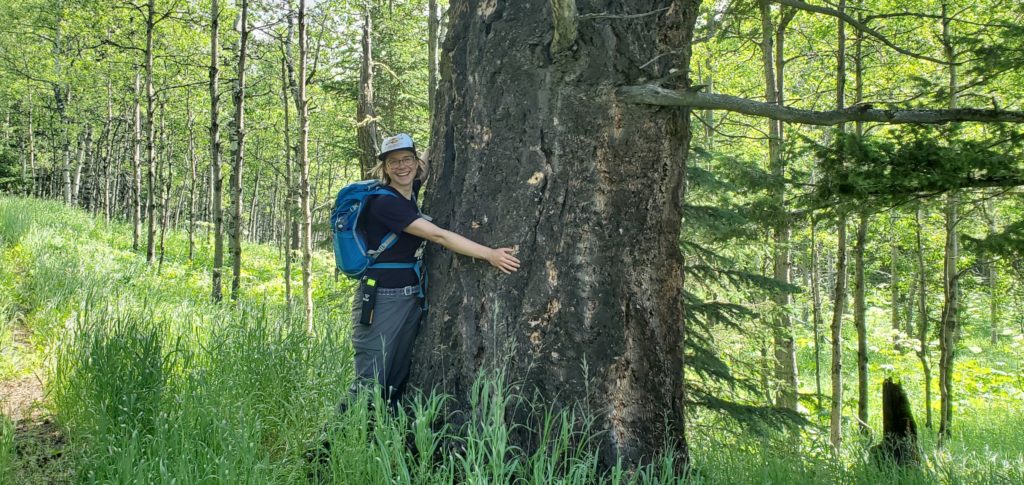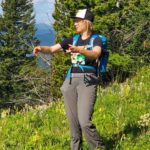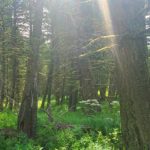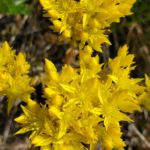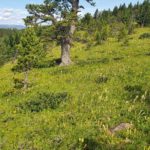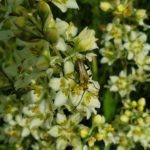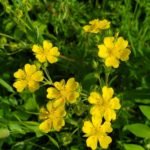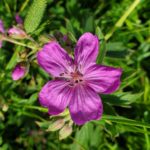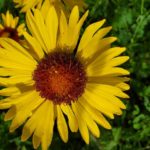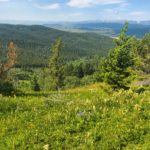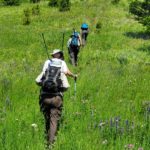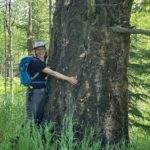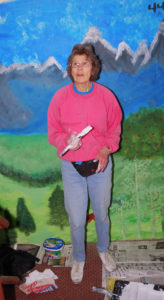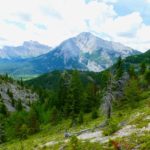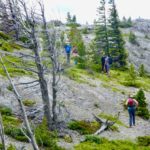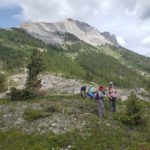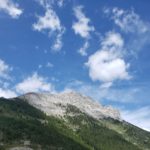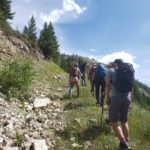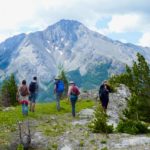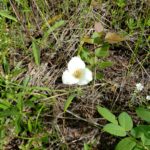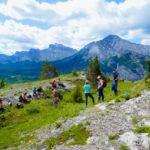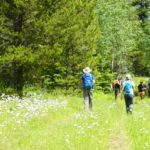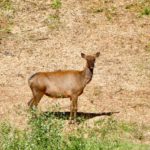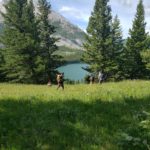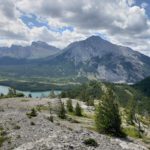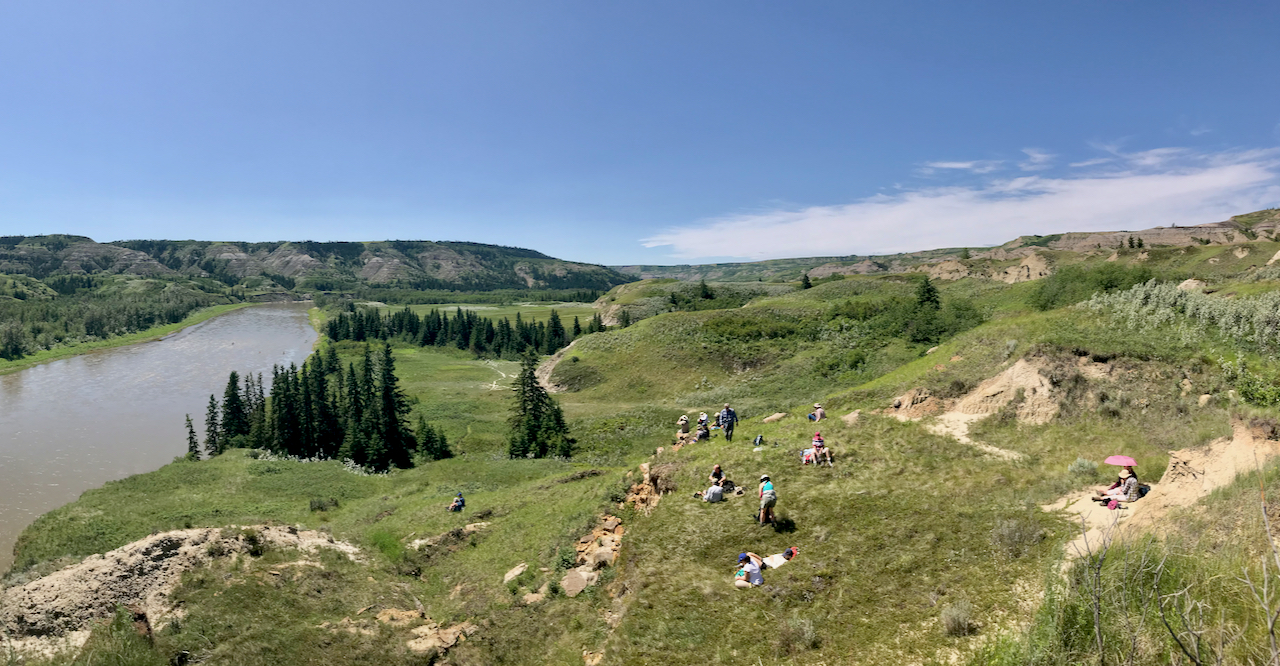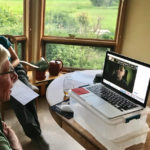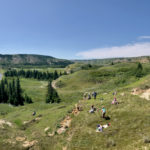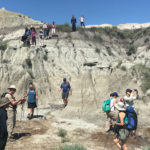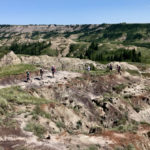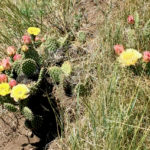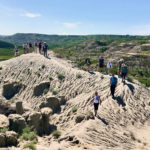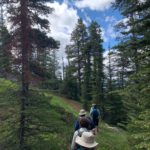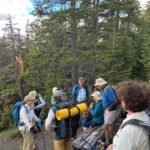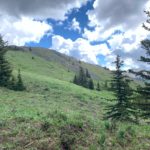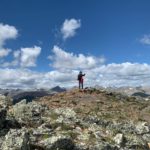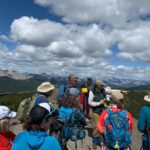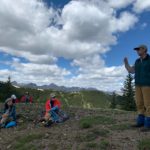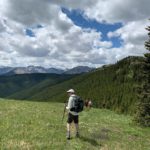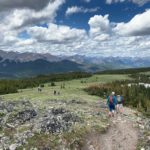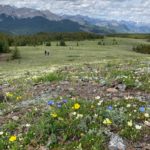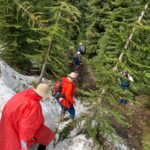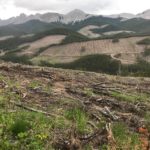A Gem of Southern Alberta: Fall Whaleback Exploration
Written on September 22, 2020, by Sean Nichols
Conservation Specialist Nissa Petterson writes of taking a fall adventure with Nick Pink to the Whaleback on September 11, 2020:
Whether it is spring or fall, the Whaleback never disappoints. With golden prairies accenting the undulating montane wilderness to the west, the Whaleback is a picturesque gem of southern Alberta and I welcome any opportunity to explore it.
Our adventure began at the Maycroft Provincial Recreation Area, 15 km south of the Whaleback trial head which is located within the Bob Creek Wildland Provincial Park and Black Creek Heritage Rangeland. It was here we met our fellow adventurers. As you drive up the gravel road running parallel to the Oldman river, which was filled with fly fishermen looking to catch trout, the blackened ridges of this montane wilderness become more prominent, and the reason for its namesake a little more clear. Folks long before us perceived the prominent forested ridges of this area to resemble the spine of a breached humpback whale.
At the trail head, we met some bow hunters returning from an overnight reconnaissance trip, noting the beautiful views and warm weather. As we started on our journey, we quickly discovered our day would be a warm one. By lunch, we were mostly in t-shirts and shorts soaking up the sun on top of the ridges. The gnarly limber pines growing through the folded rocky outcrops were often rest points offering bits of shade and great photo opportunities. As we continued along our trail, our small group shared personal outdoor tidbits and facts about the Whaleback. This included tricks in identifying Douglas fir pinecones and balsamroot, discussing the threat of white pine blister rust to limber pines in the area, and attempting to spot Clark’s nutcrackers after hearing their unique call.
While our adventure group may have been small, our experience in the Whaleback was great in many ways. We shared stories and laughs, which made for a special experience in a beautiful place. I look forward to future adventures in the Whaleback to share its exceptional beauty and the friendship that it fosters.
Beautiful grasslands and spectacular views: a ramble around the Milk River Ridge
Written on September 13, 2020, by Sean Nichols
What does sustainable ranching look like among one of Alberta’s largest remaining blocks of native fescue grassland? Chris Saunders and several other adventurers took a field trip down to the Milk River Ridge to find out:
At about 9.30 am on September 9, 2020, 11 hikers assembled on the top of the Milk River Ridge at the Taylor Ranch ready to start on a hike in a westerly direction along the ridge. The weather was warm and sunny and, uncharacteristically for the area, there was no wind.
The Taylor Ranch leases a substantial amount of public land on the Milk River Ridge and grazes cattle on it. The Taylor Ranch is well known for high priority it places on the health of its grassland.
Before setting out the group was met by Audrey Taylor, one of the joint owners of the ranch. She explained her ranching philosophy which can be summarized as: the mission is to grow top quality grass and the success of all ranching operations flows from that. She indicated the Taylor Ranch seeks, as a very general rule, to leave 50% of the grass growth on the land and uses the other 50% to feed the cattle. She speculated that many other ranchers will use 80% for feeding which produces a significantly different landscape. She noted that the Taylor Ranch takes a different approach to many ranchers with respect to grazing by leaving more cow/calf units in place on a particular piece of land for only 1 month compared to much fewer units for 6 months. She believes this produces much better results for the grass and claims that a couple of weeks after the cattle leave the piece of land the grass has returned to its former state before the grazing started.
Audrey also described how she has turned down companies seeking to use her ranch land for oil exploration and production, wind power production and power lines.
After the meeting with Audrey, the group set off across the grassland, crossing 2 fences, to a magnificent viewpoint for lunch. This showed Miami Lake and related wetlands in the foreground and a panoramic view of the mountains to the west in both Canada and the US. Since there are no trails to follow it was necessary to simply walk through grasses ranging in height from a few inches to 2-3 feet. There are a lot of animal holes, created by badger, ground squirrel, foxes, coyotes and other animals. It was always necessary to look carefully to see where one was placing one’s feet. Falling into one of these holes could easily result in serious injury.
At lunch Cliff recounted his experiences, as part of AWA’s team, in helping to defend the Ridge from industrial development over many years.
After lunch the group walked down to the sandy beach of Miami Lake and took a different route back to the starting place, a total of about 9 km for the day.
Throughout the hike there was a tremendous variety of grasses, sedges and other similar plants to be seen, likely several hundred species. Cliff provided a wealth of information on what the group was seeing. In addition Tako provided interesting commentary on the geology of the area. For all of the participants this Adventure was a chance to learn a lot about the Milk River Ridge; its vegetation, wildlife, landforms and agriculture.
Field Tripping Southern Alberta
Written on September 13, 2020, by Sean Nichols
Adventure coordinator Tako Koning recounts a field trip to see orphan gas wells in southwestern Alberta:
The group consisted of 14 participants and as we drove towards the bird blind at Frank Lake, five km east of High River, we saw over 200 beautiful white pelicans resting on a small island near the western edge of the lake. So, this was an excellent start to our field trip. Encouraging also was that the weather was excellent with just a touch of autumn in the air.
After visiting Frank Lake and photographing the pelicans as well as numerous water fowl and shore birds, we drove a couple of miles northwards and stopped at a sign indicating the presence of a nearby gas well which was “left behind” when the oil company went bankrupt. This well is an “orphan” gas well which has been left in a suspended state for 15 years and needs to be properly abandoned and the well site environmentally remediated. The Orphan Well Association, funded by the oil industry and Alberta government (thus we the taxpayers) will need to cover those costs. About 1,500 such orphan wells occur in the area from Vulcan to Frank Lake and down to the southern Porcupine Hills.
We then stopped along the road near the large, 35-year-old Mazeppa Gas Processing Plant which was also abandoned by the same oil company and needs to be dismantled and the site environmentally brought back to its original state. The cost of this will be many millions of dollars. One cannot but wonder how many more such abandoned facilities exist in Alberta. A lively discussion took place about this huge problem. We were fortunate to have a diverse group of attendees such as an engineer, accountant, lawyer, greenfield horticulturist, corporate business consultant, geophysicist and myself being a petroleum geologist engaged in the discussions.
We then proceeded southwards to Stavely and then westwards to the Willow Creek Reservoir which is an important source of water for that area for irrigation as well as sports fishing. The small and beautiful Willow Creek Municipal Park was our lunch stop. Further westwards we visited another orphan gas well and then drove into the Porcupine Hills to enjoy stunning views at the crest of those hills and discuss the underlying geology. The trip ended in Longview where we stopped at a producing oil well located smack dab in the middle of the town. The participants were reminded that eventually that well and other producing oil wells in that area, when they stop producing oil, will need to be properly abandoned by the oil company, the well sites remediated, and all oil producing infrastructure removed. This will need to be done by the oil company and not by we tax payers.
This field trip taught the attendees that Alberta and all of Canada has much benefitted from the oil industry in terms of jobs, royalties, and tax revenues and has provided enormous funds for the building of highways, roads, schools, hospitals, universities, etc., but that there are also significant environmental issues which must be addressed.
– Tako Koning
Trivia in the Garden: A war of wits in support of wilderness
Written on August 24, 2020, by Sean Nichols
Adventure coordinator Sean Nichols talks about hosting a charity trivia event in the AWA garden during the times of Covid:
For most of the ten days leading up to AWA’s Trivia for the Wild adventure on August 15, the weather was looking to be pretty miserable. Our otherwise splendid August notwithstanding, the forecast was predicting rain, wind and cool – if not downright chilly – temperatures. With some nervousness, I began trying to decide how to apportion space heaters to the tents so the contestants wouldn’t be freezing, and trying to figure out how to host and emcee a trivia contest, with a computer, while standing out in the rain.
When AWA first began planning the Adventures for Wilderness schedule back in January, and was brainstorming ideas, a charity trivia contest seemed like a great idea. It goes without saying, of course, that AWA strongly advocates getting out into the wilderness and experiencing Alberta’s wondrous natural beauty firsthand. So naturally most of the adventures in the program affirm that philosophy. It’s heartwarming seeing the map of Alberta fill up with adventures taking place, and getting adventurers out into, all corners of the province. But there are of course many Albertans for whom an outdoors and possibly physically demanding adventure, taking up an entire day or more, is not a realistic commitment. Holding a trivia night closer to home, where we could include education and presentations championing the defence of Alberta’s Wilderness, seemed like a great complement. So we quickly added it to the schedule, and as a certified (and certifiable) trivia hound, I quickly volunteered to host.
How much the world has changed since January!
Through much of the spring, and the weeks and months that followed, we put the trivia night on hold, unsure when, or how, to hold it; or indeed whether it would be feasible at all given health concerns and all that 2020 seems determined to throw our way. Until finally we hit on the idea of holding it outside, on the AWA grounds in Hillhurst, with a reduced number of teams granted individualized tents, sitting at a socially-responsible distance from each other.
Trivia for the Wild was re-christened Trivia in the Garden, a Saturday afternoon date was set for mid-August when we hoped the weather would be nice, and it was game on!
Thus with a slightly sinking feeling I kept watching the weather forecast as inclement weather was predicted, wondering if “game on” would turn into “washed out.”
Hurray and huzzah, the day before the tournament gave proof to the wisdom that one should never trust a Calgary weather forecast as the rain held off and we were instead treated to a glorious warm and sunny afternoon. We set up the tents, now to shield the contestants not from the rain but the sun, and I was glad for having many cold drinks on hand to provide the weary warriors.
And true warriors of wisdom they proved to be. As host and question-setter, I knew there might be some true trivia veterans in the field, but possibly also some teams with Wilderness lovers out for a fun afternoon, who might have less “insider experience” with some of the tropes and standards of the trivia circuit. Of course I wanted to ensure that questions were fair for everyone, but also, that all teams would have a fun afternoon, regardless of what place they came in.
I needn’t have worried. With the restrictions in place we indeed had a reduced number of contestants, but the quality of the competition was as strong as ever, across the entire board. Most questions were answered correctly, many by all teams present, and at the end of the day, but a few points separated the teams on the roster.
Indeed it was a team of trivia veterans (team “One Ball Short”) that took home the top cash prize (and more importantly, bragging rights!) but they were chased all the way there by a whip-smart team (team “Trivia Challenged”) that, though less-experienced, came within a question or two of winning. They themselves were not far ahead of the bronze place winners (team “Sweet Wild O’ Mine”).
And of course it was not all hard work! We made sure that it would be a fun afternoon for everyone, and even teams that did not come out on top went home with prizes including AWA-branded bandanas (useful as face masks!) and home-made jam, for best wrong answers:
Question: What do the initials “TCBY” stand for in the name of the chain of dessert restaurants?
Answer: “Thanks. Come back, You.”When it was all over, everyone went home with smiles on their faces and a greater appreciation for Alberta’s Wilderness, having had a fun afternoon. What more could we ask for in these strange times?
Sean Nichols
Hiking Southern Alberta’s Porcupine Hills
Written on August 24, 2020, by Sean Nichols
Among those who know of them, southern Alberta’s Porcupine Hills are renowned for their fantastical bouquet of wildflowers that paint the landscape every summer. Joel Van Riper went on AWA’s adventure to visit them earlier this July and recounts his trip:
The morning of the adventure everyone made their way through thick fog to meet in Chain Lakes Provincial Park and convoy to the staging area at the bottom of the Porcupine Hills Ridge. The plan was to first ascend the North side of the ridge, but after learning that a locked gate may pose a problem, we parked our vehicles at the staging area atop the ridge. By the time we arrived at the staging area the sun had burned off the morning fog and we were immediately rewarded with a crystal-clear view overlooking the Southern Eastern Slopes dotted with welcoming cotton ball clouds, and diverse communities of wildflowers greeted us with their vibrant colours and the familiar aroma of summer in Alberta.
A short distance from the staging area a small clearing in the trees provided the only view to the East, which stretched across the landscape so far the horizon and sky mixed into a soft blue medley. After trekking across the ridge, we stopped to have a quick snack near a hoodoo before we set out on a challenging decent through an ancient old growth forest and chest-high fescue grass. Upon reaching the end of the trail we enjoyed a relaxing lunch in the cool shade of an aspen grove.
Once everyone was feeling refreshed, we began our ascent back up the ridge, and we took an off-trail route through the forest to avoid some of the steeper, less forgiving sections of the trail. When we reached the top of the ridge Joanna Skrajny entertained everyone with fun facts and stories of the region’s history and conservation struggles before making our way back to the staging area. This adventure was the perfect combination of pleasant weather, remarkable scenery, and delightful company.
– Joel Van Riper
In Memoriam – Margaret Main: the Heart of the Climb for Wilderness and AWA Events
Written on August 4, 2020, by Sean Nichols
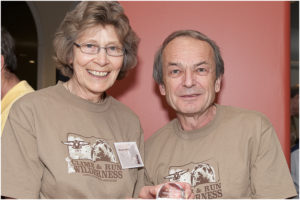 It is with great sadness and fond memories that we say goodbye to longtime volunteer and dear friend to AWA, Margaret Main.
It is with great sadness and fond memories that we say goodbye to longtime volunteer and dear friend to AWA, Margaret Main.
Those of us who have participated in AWA events in and around Calgary over past several decades will surely recall on numerous occasions being greeted by her warm smile and helped by her omnipresent cheerful enthusiasm.
She has been always present, and always ready with a helping hand at our talks program, the erstwhile Masters of Teaching program, the Martha Kostuch Annual Wilderness and Wildlife Lecture, AWA’s annual Wild West Gala, and many more events. Even as those events developed over the years and changed in response to the changing times, one constant has always been Margaret’s presence.
However it is with the Climb for Wilderness that Margaret’s name is near-synonymous, and specifically, the 14 years of Mural Competition at the Calgary Tower.
As one who spearheaded the initiative in 2003 to broaden the activities surrounding the Climb for Wilderness, the results were quintessentially Margaret. Over the following decade and a half, the drab concrete stairwell on the inside of the Calgary Tower was turned under her guidance into a place of joy and beauty, with figurative (and illustrated) flowers blooming in a place of monotony. Thanks largely to Margaret’s ongoing efforts, year after year, to keep the contest going and the paint flowing, climbers at the tower were able to truly enjoy their outings in the tallest art gallery in the world. In this way, with over 140 murals completed in the tower, Margaret truly and literally, made her mark on the Calgary landscape.
With the majority of tower painters in the mural competition being school-aged, it was entirely natural that Margaret would take on this leadership role. In her life outside AWA, Margaret’s other great passion was for teaching, and for her students: over the years Margaret taught at several Calgary elementary schools, finding her calling teaching and mentoring children in schools with under-served community members.
As an avid letter-writer, Margaret also maintained lifelong friendships and long-distance family relationships. Margaret loved to spend time birding with friends and hiking in the Canadian Rockies with family and friends—all of whom will miss her dearly.
As AWA’s Adventures for Wilderness continue to fill the calendar of the new decade, we will remember the roots of this program and some of its early days under Margaret’s kind watch. We are honoured to have known her, learned from her and will remember her forever.
Margaret Main
October 10, 1935 – July 15, 2020
If friends so desire, Margaret’s family would like to remember her passion for wilderness and wildlife with memorial donations to the Alberta Wilderness Association.
Gifts may be made online at www.albertawilderness.ca/donate or by mailing to:
Alberta Wilderness Association
455 – 12th St NW, Calgary AB T2N 1Y9
High on the Mountain of Love: a Weekend for Wilderness in the Castle Wildland
Written on July 29, 2020, by Sean Nichols
Adventure coordinator Grace Wark shares her story about a weekend away from it all in the Castle:
It’s 6:34 a.m. and I’m searching for my car keys. I need to pick up Joanna by 7.a.m. so we have enough time to load 50 to 60 lbs of gear, snacks and water into the car, hit the QE2, and make it to the trailhead before high noon. Not the earliest start by backpacker standards, but early enough that we stop at Tim Horton’s for a final boost of caffeine to get us through the day.
This is my first time in the Castle Wildland, and after taking my first and second glances at the dusty red Front Ranges, I can already see what sets them apart from the rest of the Eastern Slopes. These mountains feel shorter, more rounded and almost less intimidating than the towering peaks in Banff and Kananaskis Valley. The east-west ridges of the Front Ranges are stacked like dominoes towards Waterton Lakes National Park. Our valley of choice runs up South Drywood Creek, with a final destination of Bovin Lake. All in, a 20 km round trip with 750 metres of what I would call steady elevation gain.
The first four kilometres of the trail follow the grated Shell Road. Not so far from the road, we can still hear the rumble of active well pads, well-marked with warning signs for passersby. After those four kilometres, the difference between the designated hiking trail and the Shell road is night and day. The echo of well pads is slowly fades into the distance as we clamber up the pathway into an explosion of bright and colourful wildflowers. Diversity here absolutely thrives beyond the reach of road-introduced invasive species and free-roaming cattle. From our collective memory, we spot forget-me-nots, columbines, lupines, sticky geranium, paintbrush and even provincially rare pink Monkeyflower.
Before turning corners or ambling into thickets of willow and dogwood, we find ourselves instinctively shouting “Hey bear!” or “Is there anybody out bear?” (to the tune of Pink Floyd’s Is There Anybody Out There?) to make sure we don’t startle our company. Mountain valleys like these are perfect for an ambling grizzly bear, full to the brim with bearberries and currants, and quiet, save the low roar of the creek, bird calls, and “chirping” Richardson’s ground squirrels.
This area is distinctly different from the Castle Provincial Park lands to the north, valuable in their own way but more heavily trafficked. Here in the Wildland, away from the road and the busy off-highway vehicle trails, these lands have very few signs of disturbance. We were almost shocked to reach the old OHV gate at the top of the trail, as we almost forgot this was once used as a motorized trail. Since the phase-out of motorized trails from this area in 2018, the landscape has already started to recover the large erosion gullies and braided trails from heavy flooding and motorized use.
After reaching the lake, setting up our tent, and recharging our electrolytes, we scramble up the ridge and find the perfect spot to sing Bruce Springsteen’s cover of Mountain of Love (a very specific sponsor request). Perched on top of a bleached old tree in full view of the valley, we were indeed feeling pretty “high on the mountain of love”. How could you not fall in love with the views, the emerald blue lake and choice company provided by a couple other groups of hikers and a chunky beagle named Hoser.
Despite the achy joints, the midnight thunderstorm and the persistent horseflies, there was absolutely nothing that could have spoiled this picture perfect two-day backpacking trip up the Front Ranges. If you have the chance and are able, I would highly recommend a day-trip or overnight hike to Bovin Lake. It was just what I needed to not only recover from my long-stay at home and otherwise busy schedule, but to remind me why we fight so hard to protect the Castle. I invite you to fall in love as I have, and join us in stirring up some trouble to keep it this way. More on that here.
Happy trails,
Grace & Joanna
Camping on Mount Tecumseh: an adventure among the wildflowers
Written on July 22, 2020, by Sean Nichols
Adventure coordinator Carol Ostrom shares her story about an overnight camping trip and hike up the slopes of Mount Tecumseh in the Crowsnest Pass:
On June 8th the clouds spent the day pressing up the western slopes of the mountains that denote the border between B.C. and Alberta. Just as the first campers arrived, as though planned as a greeting, the rain started. “Its nothing,” I reported, “We are in the top of a mountain pass, it will pass.” The rain lasted just long enough for all the campers to arrive and locate a place to pitch their tents. From there it was all sunshine and coming together around the campfire as we put the night to bed.
Dawn introduced another beautiful day as folks crawled out of their tents to be greeted by sunshine, songbirds, and couple of dogs willing to help with breakfast details. By 9 the remainder of hikers had arrived and we headed out with a great mix of local and visiting participants.
Spring was late in coming in 2020, but as a result we have experienced an amazing ongoing display of wildflowers. The vibrancy of nature’s bouquet with reds, yellows, blues and purples was outstanding and everchanging as we traversed several different natural regions and were rewarded with spectacular views.
We purposefully mapped out the hike to stay on private lands, Nature Conservancy lands, or public lands that have limited access. It is increasingly difficult to find a place to quietly recreate as the Crowsnest has become the go-to place for OHVs. About 9 km into our hike we entered the Livingstone PLUZ (Public Land Use Zone) and immediately were witness to a group of OHV enthusiasts who were idling by a sign designating the trail up the side of Tecumseh as closed. After an obvious discussion about whether to proceed, off they roared to tear up the headwaters that well out the side of the mountain. I am pleased our government has finally agreed the trail needs to be closed, now I just need to write letters advocating for enforcement. One small step, one small voice at a time, we can stand up for the environment that sustains us.
It was 11.6 km by the time we completed the loop, with four hundred metres’ gain when we sat at the summit for lunch. The weather was wonderful, the flowers fabulous, and the company was congenial. We can hardly wait to lead another hike next year.
– Carol Ostrom
Dinosaurs and Badlands – a fun “double-header” presentation/hike combining education and exploration!
Written on July 22, 2020, by Sean Nichols
Adventure coordinators Rob and Tjarda share their story about the fun outing they organized in early July:
AWA’s two-part adventure, “Dinosaurs and Badlands”, was held on July 2nd and 3rd, 2020. The first part of this event was an evening slideshow presentation on “The Palaeontological Wonders of Alberta” delivered on-line via Zoom by one of Alberta’s prominent palaeontologists, followed the next day by a hike to the world renowned Albertosaurus bone bed in Dry Island Buffalo Jump Provincial Park. The hike portion of this event was fully subscribed with 18 participants, with an additional 15 registering for the presentation only; for a total of 33 participants.
“The Palaeontological Wonders of Alberta” by Dr. François Therrien, Curator of Dinosaur Palaeoecology at the Royal Tyrrell Museum:
This was a captivating presentation on the abundance and diversity of dinosaur fossils found in Alberta. We are one of the top five places in the world for finding dinosaurs. Dr. Therrien explained why Alberta is so rich in dinosaur fossils, which is a combination of three factors: rocks need to be of the right age, that formed when dinosaurs were alive; they need to be sedimentary rocks, which are the only type that will preserve dinosaur remains; and these rocks need to be exposed at the surface for dinosaur fossils to be discovered. Alberta has the perfect combination of all three. Dr. Therrien described the many important dinosaur discoveries made in Alberta over the past 120 years, with emphasis on the Albertosaurus bonebed originally discovered in 1910, the full significance of which only came to light after Dr. Philip Currie of the Royal Tyrrell Museum resumed excavations in 1997. What is interesting is that many of the dinosaur discoveries in Alberta were made not by professional palaeontologists, but by the general public and industry. At the end of the presentation Dr. Therrien answered in depth many interesting questions which added greatly to our knowledge of this interesting subject.
Hike in Dry Island Buffalo Provincial Park:
We had a perfect day for the hike, bright and sunny, and the wildflowers were out in full bloom. The excellent presentation the night before prepared everyone well for the hike. We also had the added benefit of having AWA member Tako Koning, a professional geologist, on the hike to explain the geological features and rocks we saw along the way.
As we walked and scrambled down fascinating badlands, crossing millions of years of geological history, we tried to imagine the lush subtropical forests and flood plains that existed here 70 million years ago during the age of dinosaurs. The park is home to two world renowned palaeontological sites: the Albertosaurus bonebed and Pisces Point. The rock formation at Pisces Point represents the last 900,000 years of the age of dinosaurs. Fossils of freshwater fish found here show that many lineages of modern fish originated in the cretaceous period and survived the Cretaceous–Paleogene (K-Pg) mass extinction. This is very significant and has drawn worldwide interest. The Albertosaurus bonebed is significant for the large number of Albertosaurus found here. Domination by this animal in a single quarry suggests that these animals were living together as a pack at the time of their deaths.
We stopped for lunch on a grassy bench overlooking the Red Deer river surrounded by beautiful wood lilies and flowering cactus. After lunch we followed a deer trail across a lush wooded coulee before breaking out onto an open plain at the foot of the Dry Island mesa and walked across beautiful grassland and prairie fescue. Our route home took us over the top of Dry Island which offered great views of the Red Deer River meandering through this magnificent landscape with the Buffalo Jump in the distance.
From the positive feedback we received, the combination of a captivating presentation followed by a wonderful hike in one of Alberta’s unique landscapes, was a memorable and thoroughly enjoyable AWA adventure.
Jumping Pound Mountain Circuit
Written on June 27, 2020, by Sean Nichols
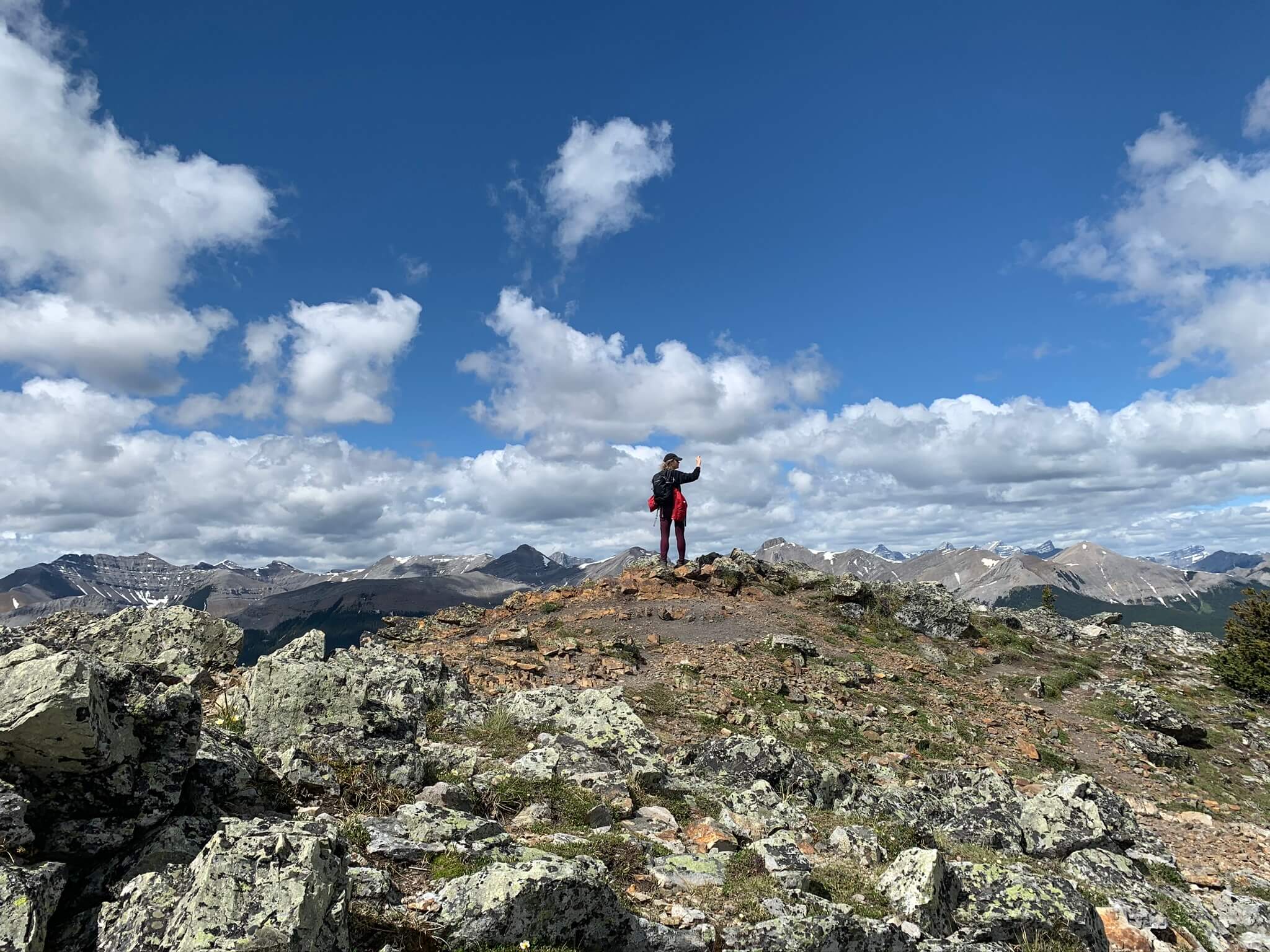
With Chris Saunders, on June 27th, 2020
Spectacular views and forest issues
At about 10 am on June 27, 2020 14 hikers assembled on the Powderface Trail ready to start on the path up Jumping Pound Mountain from the west. The weather was warm and sunny, contrary to the day’s weather forecast for Calgary.
We walked steadily uphill through beautiful mature forest, comprising largely lodgepole pine and spruce, with trees of different ages and sizes. At times the path followed clear bubbling streams, and at others there were gaps in the trees to see views of ranges of mountains to the west. After 2.5 km we arrived at the flower-strewn meadows on the west side of Jumping Pound Ridge with spectacular views of Moose Mountain and its various ridges to east. We followed the path through the meadows to the summit, an altitude gain of 417 metres (1,370 feet). After 20 minutes of absorbing the 360 degree views of mountains and prairie at the summit we followed a ridge further east to a meadow where lunch was eaten. A portion of the group took a short excursion further east along the ridge to see an exceptional meadow of flowers, again with superb views in all directions.
After lunch we returned to the summit and set off to the north along Jumping Pound Ridge. The mountains to the west and north, along with the building clouds, made for some spectacular views. However, the destruction of huge patches of forest in the valley between the ridge and the mountains to the west, through clear cut logging was only too evident. Among other things this logging has destroyed the habitat of wildlife, created significant topsoil erosion and silting of streams, and ruined the forest’s delicate filtration system which provides important flood protection. The group asked does the value created from the timber products obtained from the logging in any way offset these losses?
The route continued along the open ridge for a further 3 km with short sections through spruce trees and a climb down a big shaded snow patch. The trail then went back into the forest and descended into the valley through many switchbacks. In one section it passed directly through the devastation of a recent clear cut with no evidence of any replanting. It is clear it will take many years for new trees to grow to replace the forest lost.
As we arrived at the finish point heavy rain started to fall. We had an excellent day with exhilarating views and beautiful carpets of flowers on the ridge and summit. We had also seen at first hand the costs of logging in the area.

